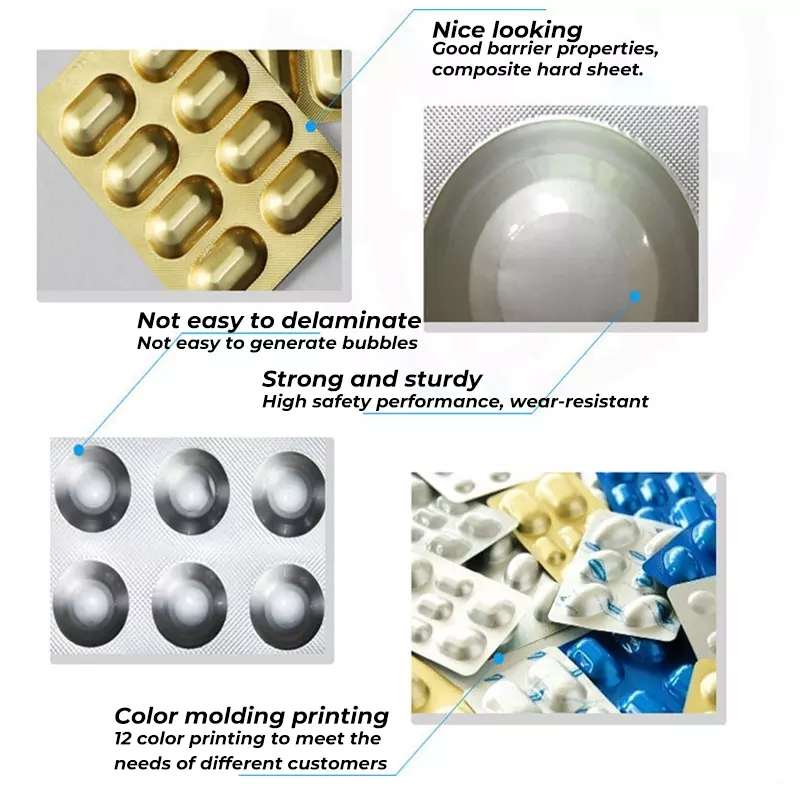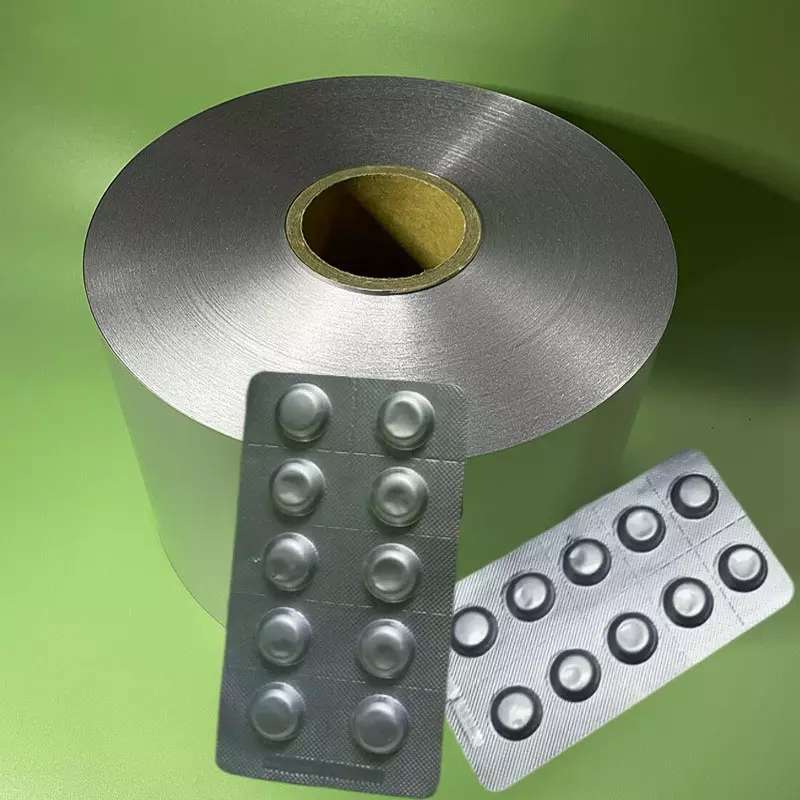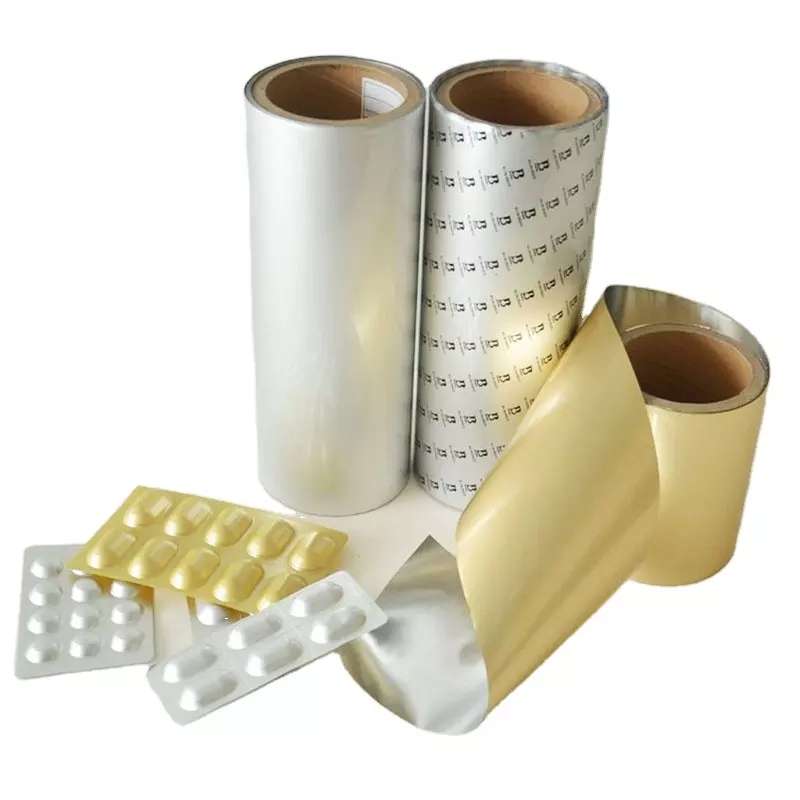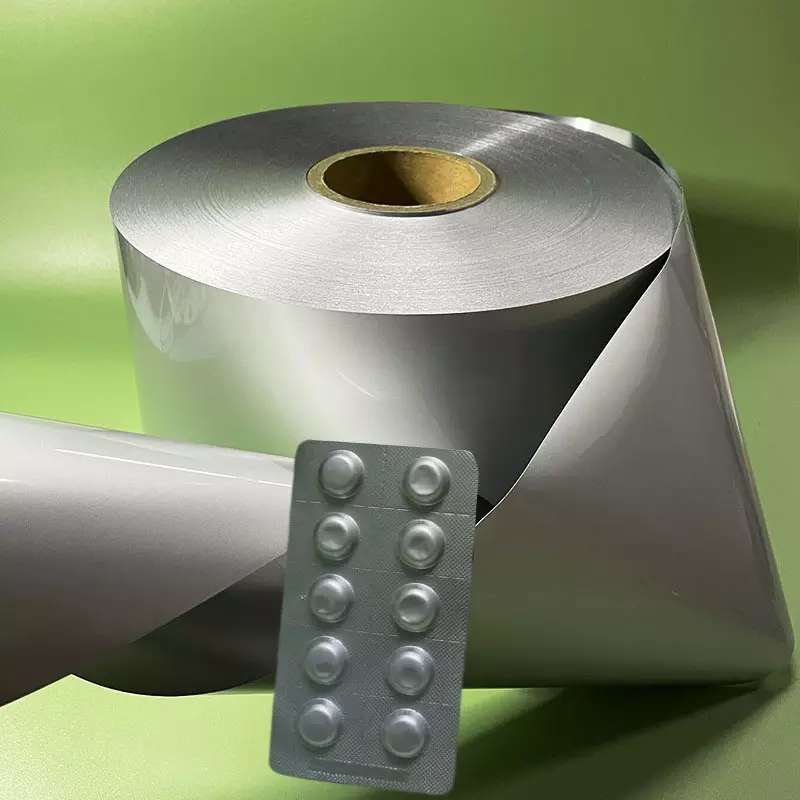Changes in the human food chain, and the frequent occurrence of food problems, human health problems have been severely tested, and various diseases are getting younger and younger. Products in this situation have also led to the development of the pharmaceutical industry, and also led the development and growth of pharmaceutical packaging, from the initial bag packaging, bulk packaging, foam packaging, and aluminum film packaging to the current paper packaging, plastic packaging, glass packaging, aluminum foil packaging, etc. There are various packaging forms. Today, we will analyze pharmaceutical packaging.
Pharmaceutical packaging refers to the operation of dividing (filling), sealing, packaging, and labeling semi-finished products or finished products of pharmaceutical preparations with appropriate materials or containers, and using packaging technology to provide quality assurance, identification of trademarks, and descriptions for drugs. The general term for the processing process. The drug packaging itself can be understood from two aspects: from a static point of view, the packaging is to pack drugs with relevant materials, containers, and auxiliary materials to perform their due functions; from a dynamic point of view, the packaging is the use of materials. The technical methods of, containers and auxiliary materials are processes and operations. The role of drug packaging in the field of circulation can be divided into two categories: inner packaging and outer packaging. Its functions mainly have three aspects, namely protection function, convenient application, and product promotion.

1. Pharmaceutical packaging
Pharmaceutical packaging refers to packaging materials and containers that directly contact medicines and belongs to the category of special packaging. It has all the attributes of packaging and has its particularities:
1. It can protect the drug from being affected by the environment during storage and use, and maintain the original properties of the drug.
2. The properties of drug packaging materials themselves should have certain stability during storage and use.
3. Drug packaging materials cannot pollute the drug production environment when wrapping drugs.
4. Drug packaging materials shall not contain substances that cannot be eliminated during use that have an impact on the packaged drugs.
5. The drug packaging materials and the packaged drugs cannot react chemically or biologically. In order to confirm that pharmaceutical packaging materials can be used to package drugs, it is necessary to carry out quality control of these materials.
2. Classification of drug packaging
(1) According to the ingredients used in drug packaging materials and containers, can be divided into five categories: plastic, rubber (or elastomer), glass, metal, and others (such as cloth, ceramics, paper, and desiccant).
(2) According to the shape of drug packaging materials and containers, it can also be divided into containers (such as oral solid pharmaceutical high-density polyethylene bottles, etc.), hard tablets or bags (such as PVC solid pharmaceutical hard tablets, composite films for drug packaging, bag, etc.), plug
(such as medicinal chlorobutyl rubber stoppers), caps (such as tear-off aluminum caps for oral liquid bottles), and auxiliary uses (such as infusion ports).
3. What are the pharmaceutical packaging materials?
Pharmaceutical packaging materials refer to the materials used in the manufacture of packaging containers, packaging, and decoration, packaging and printing, packaging and transportation, etc. to meet product packaging requirements, including metal, plastic, glass, ceramics, paper, bamboo, wild mushrooms, and natural fibers. , chemical fibers, composite materials, and other main packaging materials, including coatings, adhesives, strapping tapes, decoration, printing materials, and other auxiliary materials.
Classification of packaging materials: packaging tape, packaging tape, plastic packaging tape, plastic packaging tape, stretch film, PE stretch film, PE stretch film, and many other packaging materials.

4. What kind of requirements do medical packaging bags need to meet?
1. Certain mechanical properties: The packaging material should be able to effectively protect the product, so it should have a certain strength, toughness, and elasticity to adapt to pressure and impact. Effects of vibration isostatic and dynamic factors.
2. Barrier performance: According to different requirements for product packaging, packaging materials should have certain barriers to moisture, water vapor, gas, light, aroma, odor, heat, etc.
3. Good safety performance: The toxicity of the packaging material itself should be small, so as not to pollute the product and affect human health; the packaging material should be non-corrosive, and have the properties of anti-insect, anti-moth, anti-rat, inhibiting microorganisms, etc. to protect the safety of the product.
4. Appropriate processing: Performance packaging materials should be suitable for processing and easy to be made into various packaging containers. It should be easy to mechanize and automate packaging operations to adapt to large-scale industrial production. It should be suitable for printing and easy-to-print packaging signs.
5. Good economic performance: Packaging materials should have a wide range of sources, convenient materials, and low cost. The used packaging materials and packaging containers should be easy to handle, not pollute the environment, and avoid public nuisance.
5. Quality management of pharmaceutical packaging materials
The quality management department of the pharmaceutical packaging material manufacturing enterprise shall be responsible for the quality management and inspection of the whole process of product production, and shall be directly led by the person in charge of the enterprise. The quality management department should be equipped with a certain number of quality management and inspection personnel, and have places, instruments, and equipment suitable for the production scale, variety, and inspection requirements of pharmaceutical packaging materials.
6. Standard system for pharmaceutical packaging materials
In order to ensure the safe and effective use of drugs, all countries carry out quality control on drug packaging materials and containers. The standard system mainly includes:
1. Pharmacopoeia system: The appendixes of the Pharmacopoeia of all developed countries contain the technical requirements for drug packaging materials.
2. ISO system: Formulate standards according to materials and shapes (such as aluminum caps, and glass infusion bottles).
3. The industrial standard system of various countries: such as British Industrial Standard BS, etc., has gradually transformed into ISO standard.
4. Domestic standard system: The industrial standard is the same as the ISO standard in form, and the safety items are slightly less than those of the advanced national pharmacopeia. In order to effectively control the quality of pharmaceutical packaging materials, the State Food and Drug Administration has formulated and promulgated corresponding quality standards for pharmaceutical packaging material containers since 2002 and strengthened the control over the physical, mechanical, chemical and safety properties of the materials.
International standards and national pharmacopeia are the technical basis for the international market of pharmaceutical packaging. Among them, pharmacopeia focuses on the safety evaluation of materials and containers, and international standards focus on the evaluation of product performance.

7. Introduction to the Quality Standard System of Pharmaceutical Packaging Containers in Various Countries
1. United States Pharmacopoeia
Items controlled by glass products include light transmittance test, water resistance test, arsenic leaching test, etc.;
Control items for PE or PET products (applicable to oral solid preparations) include infrared measurement, thermal analysis, light transmittance test, water vapor transmission measurement, heavy metal, non-volatile matter measurement, etc.
2. Japanese Pharmacy
The testing items for glass containers for injections are: sealing requirements, soluble alkali (water resistance) measurement, iron measurement (light-proof container), and light transmittance measurement;
Special requirements for plastic containers are:
(1) The dissolution or migration of the container should be investigated
(2) The physical properties of the container should be investigated
(3) The barrier properties of the container should be investigated
(4) The tolerance to severe weather should be investigated
(5) The sterilization resistance of the container should be investigated
(6) Evaluation of container toxicity in the design stage.
Among them, the testing items for rubber stoppers for injections include: cadmium, lead, leachate test, acute toxicity test, hemolysis test, and pyrogen test;
The testing items for PE or PP injection containers are: transparency, water vapor transmission, heavy metals, cadmium, lead, leachate test, cytotoxicity test;
The testing items for PVC injection containers are thickness, transparency, leakage, flexibility, water vapor transmission rate, cadmium, lead, tin, vinyl chloride monomer, insoluble particles, leachate test, cytotoxicity, etc.
3. European Pharmacopoeia
The main plastic materials used are PE (divided into additive-free and additive-containing PE), PP, and PET.
The main control items for the above materials are: identification (infrared spectrum and density test), leachate test, metal ion, ash test, and additive inspection;
The items controlled for glass containers include: water resistance, light transmittance, thermal shock resistance, arsenic, etc.; PVC materials are divided into PVC for intravenous infusion containers (containing plasticizers) and PVC without plasticizers (suitable for a non- liquid bottle for injection). The control items for the above materials are infrared identification, leachate test, metal ion, ash test, additive inspection, vinyl chloride content determination and vinyl chloride monomer control, etc.;
The control items for the rubber stopper are identification, leachate test, volatile sulfide, puncture force, puncture chipping, self-sealing, etc.

4. ISO standard
The international standards formulated by the International Organization for Standardization are the technical guarantee for the smooth progress of international trade. Among them, ISO/TC76 takes the formulation of pharmaceutical packaging materials and container standards as the main work content.
The standards for pharmaceutical packaging materials included in ISO are:
ISO8362-1 Injection containers and accessories – Part 1: Controlled glass injection bottles, ISO8362-4 Injection containers and accessories – Part 4: Molded glass injection bottles, ISO8536-1 Medical infusion sets – Part 3: Glass infusion bottles, ISO9187-1 Ampoules for Injection, ISO9187-2 Point Score Ampoules, ISO11481-1 Bottles for Drops, ISO11481-2 Screw Bottles for Syrup, ISO11481-3 Screw Bottles for Solid and Liquid Medicines, ISO11481-4 Tablet Bottles, ISO8362 -3 Injection Containers and Accessories-Part 3: Aluminum Caps for Injection Bottles, ISO8536-3 Medical Infusion Sets-Part 3: Aluminum Caps for Infusion Bottles, ISO8872 Blood Transfusion, Infusion, Aluminum Caps for Injection Bottles-General Requirements and Test Methods, ISO8362- 6 Injection containers and accessories-Part 6: Aluminum-plastic composite injection bottle caps, ISO8536-7 Medical infusion devices-Part 7: Aluminum-plastic composite infusion bottle caps, ISO10985 Infusion bottles and injection bottles Aluminum-plastic composite caps-Requirements and tests Methods, ISO8362-2 Injection containers and accessories – Part 2: Injection bottle stoppers, ISO8362-5 Injection containers and accessories – Part 5: Lyophilized injection bottle stoppers, ISO8536-2 Medical infusion devices – Part 2: Infusion bottles Bottle stoppers, ISO8536-6 Medical infusion devices – Part 6: Freeze-dried stoppers for infusion bottles, ISO8871 elastic parts for parenteral water preparations, ISO15747:2003 Plastic containers for intravenous injection, etc.
5. YBB standard
In order to strengthen the quality control of pharmaceutical packaging containers, the State Food and Drug Administration (SFDA) formulated and promulgated the National Standard for Pharmaceutical Packaging Containers (YBB Standard) in 2002 on the basis of a full investigation of product quality in the early stage. in:
In 2002, the second series of 34 standards were promulgated;
In 2003, the second series of 40 standards were promulgated. There are 47 product standards involved, including 2 product general rules, 45 specific product standards, 26 method standards, and 1 guideline for drug packaging materials and drug compatibility testing. Including 19 plastic products, the types include infusion bottles (bags), eye drop bottles, oral solid (or liquid) bottles, composite films (bags), hard tablets, etc.; 5 metal products, such as aluminum foil, aluminum tube, Aluminum caps, etc.; 2 rubber products, all of which are butyl rubber products; 19 glass products, including ampoules, infusion bottles, oral liquid bottles, etc.
In 2004, another 41 standards were promulgated. There are 25 product standards and 16 method standards involved. Includes 4 plastic products, such as composite film (bag), AL/PE cold-formed composite hard sheet for a suppository, oral solid moisture-proof combination bottle cap, etc.; 2 metal products, such as aluminum cap for pen-type syringe, injection needle, etc.; 7 rubber products; types include polyisoprene gaskets, silicone rubber stoppers for oral liquids, pistons for pen-type syringes, and pistons for pre-filled syringes; 8 glass products, including medicine bottles, infusion bottles, oral liquid bottles, etc.; 1 gelatin for capsules; 3 combined products, such as combined caps for infusion containers, sealing gaskets, pre-filled syringes, etc.
The standards for pharmaceutical packaging materials formulated and promulgated by the SFDA are the national legal standards to ensure the quality of pharmaceutical packaging materials and the safety and effectiveness of drugs. legal standards for materials. The items controlled by the YBB standard for different materials cover identification tests, physical tests, mechanical property tests, chemical tests, and microbiological and biological tests. The setting of these projects provides a basic guarantee for the safe and reasonable selection of pharmaceutical packaging materials and containers and also provides technical support for the country to implement the national registration system for pharmaceutical packaging containers.
